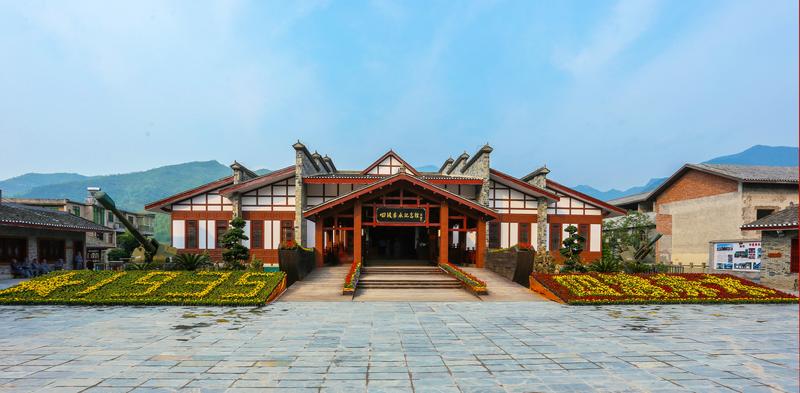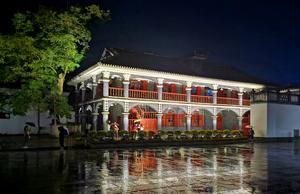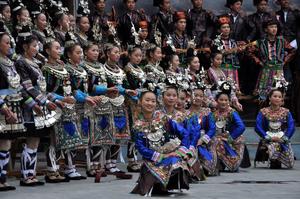Province preserves sites and artifacts from significant period in time, integrating them with local culture, report Yang Jun in Guiyang and Yang Feiyue in Beijing.
 The memorial hall in Xishui county, the site of a key battle during the Long March in the 1930s. (PHOTO PROVIDED TO CHINA DAILY)
The memorial hall in Xishui county, the site of a key battle during the Long March in the 1930s. (PHOTO PROVIDED TO CHINA DAILY)
In southwestern China, Guizhou province was an important site during the Long March. This was where the Red Army recuperated and went from setbacks to victory. From September 1934 to April 1936, the army trekked across more than 60 cities, counties and districts in Guizhou, leaving behind a trail of rich history for future generations.
Today, Guizhou is a place filled with red culture, in which its red tourism industry focuses on tours exploring the history of the Communist Party of China before the founding of the People's Republic of China in 1949.
Along with Guizhou's magnificent natural landscape, the province has become an ideal place for red tourism.
Local authorities have tapped into the province's Long March historical significance and integrated it with ethnic, cultural and ecological elements, fueling red tourism development over the years.
According to the local government, many red tourism spots in Guizhou have seen sharp rises in tourist numbers, especially this past Spring Festival and National Day holiday last year.
Also, young people have shown increasing interest in red tourism, with those born in the 1980s and '90s accounting for 40 percent of all tourists.
 The site of the Zunyi Conference in Guizhou province is the region's most popular red tourism spot. (YOU YOUHAI / FOR CHINA DAILY)
The site of the Zunyi Conference in Guizhou province is the region's most popular red tourism spot. (YOU YOUHAI / FOR CHINA DAILY)
Downtown Zunyi
Zunyi has drawn tourists from across the country over the years for the historical significance of its red tourism. Tourists can relive the Long March days of the Red Army by appreciating the large number of cultural relics, precious historical objects, photos and documents that are on display at the historical sites.
Red tourism in the city continues to grow. During this year's Spring Festival, the revolutionary memorial halls and related cultural and museum sites received about 440,000 visitors, accounting for 19.3 percent of all tourists in the city, according to the local culture, sports and tourism bureau.
The site of the Zunyi Conference is the most popular red tourism spot, with more than 4 million tourist visits a year.
From Jan 15 to 17, 1935, the Political Bureau of the Communist Party of China Central Committee held the Zunyi Conference to solve the most urgent organizational and military problems faced by the Party. The conference established Mao Zedong's leading position in the Party and the Red Army, and saved China's revolution during an extremely dangerous historical juncture.
The Zunyi Conference site opened to the public in 1955 and was one of the country's first facilities in memory of the revolutionary history. There are a large number of cultural relics, precious historical pictures and documents at the site, vividly reliving the course of the Long March.
The site uses information technology and an artistic approach to recount historical moments and offer immersive experiences.
"The scenes in the video were performed by special actors, using phantom imaging technology to restore the scene of the Zunyi Conference," says Zhang Xiaoling, vice-curator of the site.
"The isometric stereo imaging of this scale is the first of its kind at home and abroad."
 Performers play ethnic music to welcome tourists at the entrance of a Dong village in Zhaoxing, in Guizhou's Liping county. (ZHANG LIN / FOR CHINA DAILY)
Performers play ethnic music to welcome tourists at the entrance of a Dong village in Zhaoxing, in Guizhou's Liping county. (ZHANG LIN / FOR CHINA DAILY)
Liping
On Dec 18, 1934, the Political Bureau of the Communist Party of China Central Committee held a meeting in Liping county that affirmed Mao's plans. They gave up the original plan of going north to Xiangxi to join two other Red Army troops, and established a new base at the border of Sichuan and Guizhou. This enabled the Red Army to avoid the danger of falling into enemy encirclement and paved the way for the Zunyi Conference.
Liping authorities have preserved a large number of cultural relics and historical sites from the time and combined it with local Dong ethnic culture to develop its red tourism.
In 2009, the county government built a memorial hall opposite the site of the Liping Conference. Visitors can view historical items and buildings at the site. Nearby, visitors can also choose to pick tea leaves and appreciate Dong music in the neighborhood.
This past Spring Festival, the Qiaojie red tourism zone that houses the Liping Conference site and former residences of historical figures, such as Mao's, had 45,000 tourist visits and earned 43 million yuan (US$6.57 million) in revenue.
Local authorities are now working on upgrading the Liping Conference site and memorial hall, and will set up folk cultural museums on Qiaojie street, says Yang Zuhua, an official with the Liping Conference Memorial Hall.
This is in response to the country's call for developing a national Long March cultural park.
"We should strengthen excavation and organize the ancient city culture, so that the Long March National Cultural Park has a 'skeleton, flesh and blood', and fresh local culture," Yang says.
 A chorus performs the Grand Song of Dong, classified as a World Intangible Cultural Heritage, in Liping. (PHOTO PROVIDED TO CHINA DAILY)
A chorus performs the Grand Song of Dong, classified as a World Intangible Cultural Heritage, in Liping. (PHOTO PROVIDED TO CHINA DAILY)
Xishui county
Under the command of Mao and other leaders, the Red Army crossed the Chishui River four times and escaped the encirclement of more than 400,000 Kuomintang troops from January to May 1935. It was one of the most brilliant military moves by the Red Army during the Long March, and a great example of the disadvantaged gaining the upper hand.
Xishui was the main battlefield where the four Chishui River crossings took place. The county built a memorial hall in 2006 in Tucheng ancient town where the first crossing happened. A cluster of museums covering an area of 15,000 square meters was also developed, integrating local red culture with folk art and customs. To date, Tucheng boasts a well developed red tourism industry with tourist sites such as the Female Chinese Red Army Museum and the Qinggangpo battle site that are popular among tourists. There are also a number of unique facilities that showcase local culture such as the ancient salt trade.
At the battle experience park, tourists can engage in role play and experience scenes of past battles, while enjoying modern tourism elements.
The Xishui county government has also continued to improve red tourism infrastructure over the years. Chen Zhao, deputy Party secretary of the county, says the government has developed forests, wetland parks and cycling lanes to enhance the travel experiences of tourists.
Contact the writers through yangfeiyue@chinadaily.com.cn



